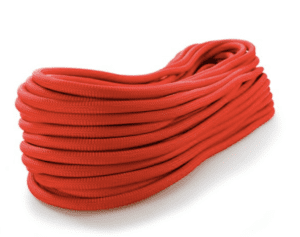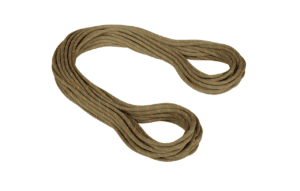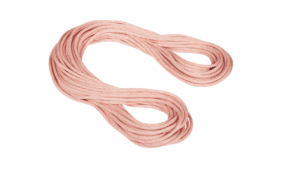What makes it a Gym Rope?
We explore what makes a good gym rope and review Maxim's Gym Rat and Mammut's Gym Workhorse Classic

Defining a “gym-specific rope” is complicated. At the end of the day, lead climbing ropes are dynamic lengths of cord that catch you when you fall. Whether you are climbing indoors or out, that much will never change. With that said, indoor and outdoor rope climbing are rather different.
When you go outside, you are probably looking to climb close or near your limit. The route is probably long, at least long enough to require 60-metres of rope, and ease of use is fundamental. Getting short-roped is the greatest fear of any red-pointing sport climber looking to project at their limit.
To combat short roping, clip fumbling, and rope drag, outdoor lead climbers will look to the narrow ropes of each company’s performance division: a lightweight project crusher that the climber will fail to notice, halfway up the wall.
When you climb inside, you are probably climbing a lot. Especially as pandemic-sessions are limited to just a couple hours, rope climbers have to get in, get their pitches done, and get out as fast as they can. That means constant wear on the rope, and, between you and your partner, a probable minimum of four pitches in a single session. If you are a more advanced climber, that number can increase dramatically.
When you are climbing inside all the time, using your high-performance projecting rope, just to crank out training routes can feel like a bit of a waste. There is always an additional 20- or 30-metres of rope just lying around on the floor. Coiling, flaking, and pulling a 60-metre is an ordeal. Furthermore, when you are projecting in the gym, you might find yourself creasing your outdoor rope on something that is designed to be a training tool. Your 9.0 mm projecting tool is just not built for perpetual strain, month after month.
Maxim Gym Rat
The Gym Rat is Maxim’s answer to the indoor lead climbing question.
Specs
The Maxim Gym Rat offers a few unique characteristics. Firstly, this gym rope 40-metres long. This means it coils fast, flakes easily, and is an easy tool for the climber moving quickly between routes. This rope also offers a wide diameter at 10-millimetres, thought the 2020 version will be sold at 9.9-millimetres. Though this is quite wide by modern standards, the rope feels small and thin in your hand, moving easily through the fingers and Petzl’s GriGri 2 belaying device.
The rope is, uniquely, dry-treated. Though this is becoming increasingly common among outdoor ropes, it is uncommon for gym ropes. The reasoning behind this is that if you are inside, it will never get wet. The advantage of this being a dry-treated rope, however, is that you can take it outside, albeit to shorter cliffs, if you so desire.
Strengths
This is perhaps one of the easiest-to-use ropes on the market. It appears to be designed specifically with the high-volume climber in mind. The short length of the rope makes it easy to move about the gym and switch off between climbs. In addition to its length, its width makes it ideal for the high volume of attempts that are typically associated with gym climbing.
Though it cinches down on itself during a fall, it does not become bound up in itself like thinner projecting ropes. When falling repetitively on a thinner rope, the climber might have to resort to a carabiner to wrench the knot open. This is not the case with the Gym Rat. The stiff design of the Gym Rat allows the climber to untie easily, pushing the knot back through itself with ease. To that effect, the rubberized ends of the rope make it easy to tie-in and is a feature that any rope company should adopt due to just how helpful it is.
The wide diameter of the rope is a welcome sight on projects as well. After multiple test falls, in the same place, on the same move, with the expressed goal of trying to crease the rope, a 180-pound climber could not come close. It is unquestionably durable and appears to be able to take large amounts of projecting-based abuse. After a day of climbing, the sheath had not even begun to fray.
In terms of handling, the Gym Rat performs well, feeling much slimmer than its advertised 10-millimetres. This is to say that it feeds well in the belay device and clips easily into quick draws. Even though the rope is relatively stiff out-of-the-box, the classic new-rope-kinks that appear implicit in fresh ropes were worked out after the first climb.
Even though the rope is stiff, it’s dynamic elongation, at 29%, is more than enough to create a soft catch.Finally, the ultimate flexibility derived from the core’s dry-treatment makes it well worth the $149 USD price.
Weaknesses
One thing that would have been nice to see is a centre-mark. A centre-mark is an indicator on the rope that shows the belayer that half of the rope is out. On this rope, that would be at the 20-metre mark. This is useful so that if a climber reaches 20-metres on route, the belayer can tell them to come down so as to avoid the rope running out when the belayer lowers them.
Finally, at 63 g/m, this rope is heavier than your conventional projecting rope. If a light-weight rope is important to you, this might not be the one for you.
Mammut Gym Workhorse Classic
If you are looking for something with a little bit more stretch, the 9.9 millimetre Gym Workhorse Classic might be the perfect rope for you.
Specs
Though the rope we tested was 40-metres long, this rope also comes in 30-, 50-, and 200-metre lengths. Though you may not find yourself picking up the 200-metre behemoth, each the 30-, 40-, and 50-metre versions of this rope are accessible tools to help you train in the gym.
Thought this rope does not have the same dry treatment as the Maxim rope, Mammut’s Workhorse has a dynamic elongation rated to 32%. This makes it a better rope for lighter climbers seeking a softer catch. This rope also comes complete with a centre-mark and is built with ultimate abrasion resistance in mind.
Strengths
Though the Workhorse and the Gym Rat appear as very similar ropes, they each offer wildly different advantages. The Workhorse features a centre-mark, an exceptionally useful tool for any climbing rope and one that can keep the climber safe.
Instead of focusing on stiffness, this rope focuses on flexibility. Though a stiff, thick rope is durable, a softer catch is frequently preferable to the indoor lead climber. With a dynamic elongation of 32%, 3% further than the Maxim, the climber’s fall is spread over a greater period of time and provides a more comfortable catch. If you are a lighter climber, this rope will provide a more enjoyable falling experience.
One of the best aspects of this rope is just how comfortable it is in hand. When belaying, it tears less on the skin, while offering superior grip. As a notably softer rope, it is easier for the climber to handle while clipping than a stiffer rope. This benefit was most noticeable on steep climbing where the twisting draws were made more accessible by the malleable rope. Out of the box, the rope feels high quality and is clearly built with abrasion resistance in mind. The outer sheath is tightly knit to shrug off the wear that ropes typically experience through use.
It’s also only $130 USD and comes in pink.
Weaknesses
The only real issue with this rope is in its proclivity for kinking. It will take a few sessions to straighten out the rope after you purchase it.
Overview
As two of the best rope manufacturers in the game, it is difficult to pick a favourite. It would seem that the best rope of these two is greatly dependent upon your preference. Heavier climbers will find the Maxim rope slightly more durable than the Mammut for repeated falls at the same bolt. If you are looking to project indoor lead routes, it is probably the best option available to you.
If you are looking for a rope that will respond easily in your hand or provide the softest catches for its width, then the Mammut will probably be the best rope for you. It is smooth and comfortable, making it ideal for the lead climber that is cycling endurance or power-endurance training on a rope.






